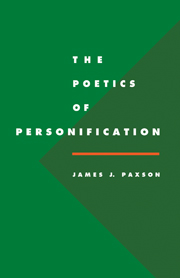Book contents
- Frontmatter
- Contents
- Preface
- Introduction
- 1 A history of personification theory
- 2 Towards a taxonomy of tropes
- 3 Narrative level, personification, and character ontology in Prudentius' Psychomachia
- 4 A phenomenology of personification
- 5 Personification, dreams, and narrative structures in Piers Plowman B
- 6 Narrating the personification of personification in The Faerie Queene
- Conclusion: Taxonomy II and future directions in personification theory
- Notes
- Works cited
- Index
2 - Towards a taxonomy of tropes
Published online by Cambridge University Press: 15 January 2010
- Frontmatter
- Contents
- Preface
- Introduction
- 1 A history of personification theory
- 2 Towards a taxonomy of tropes
- 3 Narrative level, personification, and character ontology in Prudentius' Psychomachia
- 4 A phenomenology of personification
- 5 Personification, dreams, and narrative structures in Piers Plowman B
- 6 Narrating the personification of personification in The Faerie Queene
- Conclusion: Taxonomy II and future directions in personification theory
- Notes
- Works cited
- Index
Summary
From the survey of theories about personification presented in the last chapter, we can readily see the need for a more inclusive and extensive taxonomy of personification and its coordinate tropes. The classification of figural characters, especially those in complex works such as Piers Plowman, is very difficult, as Lavinia Griffiths remarks, because contemporary theory has not yet been able to settle on a universal, working definition of the figure (4). Critics still labor under the legacy of at least two kinds of personification, both of which had been identified and studied, as chapter 1 revealed, by Morton Bloomfield, Coleridge, Lord Kames, and Fontanier. The distinction between a figure that exists strictly in speech and a figure that gets extended into an actual story probably shared origins with the allegoria in verbis/in facto commonplace first proposed by Augustine and later promoted by Bede.
Since this study takes as a focal interest the formal role of narrative in a theory of personification, the terms “personification figure” and “personification character” provide a handy taxonomical minimum with which to begin. Personification figures constitute a set that includes but is not exhausted by the subset of personification characters. The former set comprises all implementings of the trope personification in narrative, in the short lyric, in drama, in non-verbal arts, in rhetorically ornamental fictional dialogue, or in everyday speech. A personification figure, in simplest terms, must at least be a local rhetorical ornament.
- Type
- Chapter
- Information
- The Poetics of Personification , pp. 35 - 62Publisher: Cambridge University PressPrint publication year: 1994

